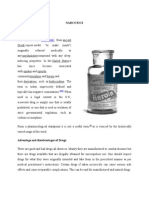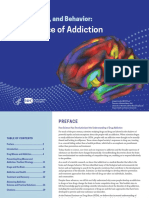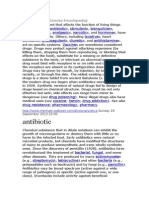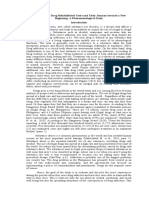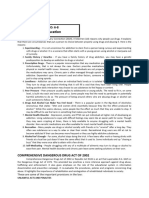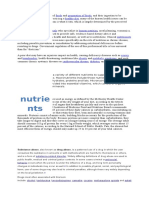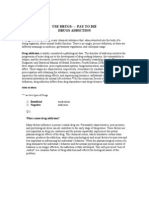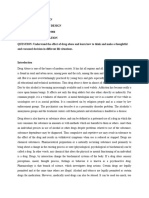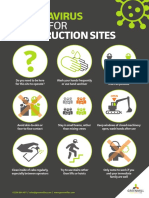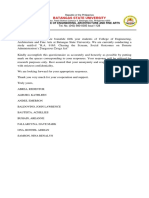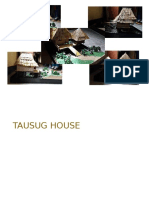0 ratings0% found this document useful (0 votes)
34 viewsResearch in MAPEH
Research in MAPEH
Uploaded by
Niña SamsonIllegal drugs are substances that are prohibited or restricted by law. They include psychoactive drugs that affect the brain and mind. While some controlled drugs are allowed with a prescription, illegal drugs have negative health impacts and their use can increase the likelihood of using other drugs. Nicotine and tobacco are examples of legal drugs that are carcinogenic and addictive.
Copyright:
© All Rights Reserved
Available Formats
Download as DOCX, PDF, TXT or read online from Scribd
Research in MAPEH
Research in MAPEH
Uploaded by
Niña Samson0 ratings0% found this document useful (0 votes)
34 views6 pagesIllegal drugs are substances that are prohibited or restricted by law. They include psychoactive drugs that affect the brain and mind. While some controlled drugs are allowed with a prescription, illegal drugs have negative health impacts and their use can increase the likelihood of using other drugs. Nicotine and tobacco are examples of legal drugs that are carcinogenic and addictive.
Original Description:
mapeh
Copyright
© © All Rights Reserved
Available Formats
DOCX, PDF, TXT or read online from Scribd
Share this document
Did you find this document useful?
Is this content inappropriate?
Illegal drugs are substances that are prohibited or restricted by law. They include psychoactive drugs that affect the brain and mind. While some controlled drugs are allowed with a prescription, illegal drugs have negative health impacts and their use can increase the likelihood of using other drugs. Nicotine and tobacco are examples of legal drugs that are carcinogenic and addictive.
Copyright:
© All Rights Reserved
Available Formats
Download as DOCX, PDF, TXT or read online from Scribd
Download as docx, pdf, or txt
0 ratings0% found this document useful (0 votes)
34 views6 pagesResearch in MAPEH
Research in MAPEH
Uploaded by
Niña SamsonIllegal drugs are substances that are prohibited or restricted by law. They include psychoactive drugs that affect the brain and mind. While some controlled drugs are allowed with a prescription, illegal drugs have negative health impacts and their use can increase the likelihood of using other drugs. Nicotine and tobacco are examples of legal drugs that are carcinogenic and addictive.
Copyright:
© All Rights Reserved
Available Formats
Download as DOCX, PDF, TXT or read online from Scribd
Download as docx, pdf, or txt
You are on page 1of 6
Submitted by Submitted to
Ymmanuel Samson Mr. Romy De Castro
Research in Health
What are illegal drugs ?
Illegal drugs are drugs which have limitations on their ownership
or use by a government, and are illegal in certain situations
(meaning a person is not allowed to have them). A drug is any
chemical that affects the human body or mind when it is
swallowed, breathed in, or consumed in another way. A
psychoactive drug is a drug that affects the brain. Some controlled
drugs are allowed if you have permission (called a "prescription")
from a doctor Examples are gateway drugs
Republic act 9211
AN ACT REGULATING THE PACKAGING, USE, SALE, DISTRIBUTION
AND ADVERTISEMENTS OF TOBACCO PRODUCTS AND FOR OTHER
PURPOSES
It is the policy of the State to protect the populace from
hazardous products and promote the right to health and instill
health consciousness among them. It is also the policy of the
State, consistent with the Constitutional ideal to promote the
general welfare, to safeguard the interests of the workers and
other stakeholders in the tobacco industry. For these purposes,
the government shall institute a balanced policy whereby the use,
sale and advertisements of tobacco products shall be regulated in
order to promote a healthful environment .
Gateway drug theory (alternatively, stepping-stone theory,
escalation hypothesis, or progression hypothesis) is a
comprehensive catchphrase for the medical theory that the use of
a psychoactive drug can be coupled to an increased probability of
the use of further drugs. Possible causes are biological alterations
in the brain due to the earlier drug and similar attitudes of users
across different drugs (common liability to addiction). Scientific
investigation of the possible causes is considered important for
health policy concerning education and law making
General concept
The concept of gateway drug is based on observations that the
sequence of first-time use of different drugs is not random but
shows trends. On the basis of established techniques of
longitudinal studies such trends can be described precisely in
terms of statistical probability. As to the interpretation of the
observed trends, it is important to note the difference between
sequence and causation. Both may – but need not – be coupled, a
question which is subject of further research, e.g., by physiological
experiments.
Examples of trends
From a sample of 6,624 persons who had not used other illegal
drugs before their cannabis consumption the overall probability of
later use of further illegal drugs was estimated to be 44.7%.
Subgroup analyses showed that personal and social conditions,
such as gender, age, marital status, mental disorders, family
history of substance abuse, Ethnicity.
Alterations in the brain
In animals it is relatively simple to determine if consumption of a
certain drug increases the later attraction of another drug. In rats,
cannabis consumption – earlier in life – increased the self-
administration of heroin,[8] morphine,[9] and also nicotine.
Nicotine is a potent parasympathomimetic stimulant and an
alkaloid found in the nightshade family of plants. Nicotine acts as
a receptor agonist at most nicotinic acetylcholine receptors
(nAChRs),[4][5] except at two nicotinic receptor subunits
(nAChRα9 and nAChRα10) where it acts as an receptor
antagonist.[4] Nicotine is found in the leaves of Nicotiana rustica
in amounts of 2–14%, the tobacco plant Nicotiana tabacum,
Duboisia hopwoodii and Asclepias syriaca
Nicotine's mood-altering effects are different by report: in
particular it is both a stimulant and a relaxant.[23] First causing a
release of glucose from the liver and epinephrine (adrenaline)
from the adrenal medulla, it causes stimulation. Users report
feelings of relaxation, sharpness, calmness, and alertness.[24] Like
any stimulant, it may very rarely cause the often uncomfortable
akathisia. By reducing the appetite and raising the metabolism,
some smokers may lose weight as a consequence
A carcinogen is any substance, radionuclide, or radiation that is
an agent directly involved in causing cancer. This may be due to
the ability to damage the genome or to the disruption of cellular
metabolic processes. Several radioactive substances are
considered carcinogens, but their carcinogenic activity is
attributed to the radiation, for example gamma rays and alpha
particles, which they emit. Common examples of non-radioactive
carcinogens are inhaled asbestos, certain dioxins, and tobacco
smoke. Although the public generally associates carcinogenicity
with synthetic chemicals, it is equally likely to arise in both natural
and synthetic substances.[1] Carcinogens are not necessarily
immediately toxic, thus their effect can be insidious.
Cancer is any disease in which normal cells are damaged and do
not undergo programmed cell death as fast as they divide via
mitosis. Carcinogens may increase the risk of cancer by altering
cellular metabolism or damaging DNA directly in cells, which
interferes with biological processes, and induces the uncontrolled,
malignant division, ultimately leading to the formation of tumors.
Usually, severe DNA damage leads to apoptosis, but if the
programmed cell death pathway is damaged, then the cell cannot
prevent itself from becoming a cancer cell.
Illegal drugs are not allowed in our modern community because of
its effects on certain people and the causes of its consumption .
either it damages the brain or the body itself , by using it, it will
damage our bodies directly so do not use drugs and study like our
life depends on it . Some parents use drugs to escape reality ,
reality that they have responsibilities , reality that they need to
suffer , so like a wise man said “ It’s not the drugs that make a
drug addict, it’s the need to escape reality”.
You might also like
- Review of Related LiteratureDocument25 pagesReview of Related LiteratureKarlvin De CardoNo ratings yet
- Psych. Substance AbuseDocument5 pagesPsych. Substance AbuseRachelle Romualdo100% (2)
- Experienced Investment Banker Resume Template Transaction PageDocument3 pagesExperienced Investment Banker Resume Template Transaction PageMohamed AbdullaNo ratings yet
- Narcotics Narcotics: Ancient GreekDocument5 pagesNarcotics Narcotics: Ancient GreekWilda Pado RiveraNo ratings yet
- Drug AddictionDocument23 pagesDrug AddictionsjvNo ratings yet
- NationalDocument14 pagesNationallosangelesNo ratings yet
- The Science of AddictionDocument32 pagesThe Science of AddictionKayciNo ratings yet
- Soa PDFDocument32 pagesSoa PDFJohnNo ratings yet
- Drugs and Substance AbuseDocument15 pagesDrugs and Substance AbuseEve Lexy MutituNo ratings yet
- Hassan Project Orginal 11Document90 pagesHassan Project Orginal 11michaelduru027No ratings yet
- Recreational Drug Use DissertationDocument7 pagesRecreational Drug Use DissertationBuyThesisPaperSingapore100% (1)
- MODULE 4 Drug EducationDocument11 pagesMODULE 4 Drug EducationArshelyn Donna NovenoNo ratings yet
- What Are Drugs!!Document6 pagesWhat Are Drugs!!CS AbdullahNo ratings yet
- Lecture On Drugs and SocietyDocument9 pagesLecture On Drugs and Societyateeyahoreoluwa12No ratings yet
- NSTP Module 3Document19 pagesNSTP Module 3BSN1G - Amistad LykaNo ratings yet
- Antibiotic: Noun (Concise Encyclopedia)Document12 pagesAntibiotic: Noun (Concise Encyclopedia)smithmccaulskyNo ratings yet
- (Gray Matter) James D. Stoehr - The Neurobiology of Addiction-Chelsea House (2006)Document113 pages(Gray Matter) James D. Stoehr - The Neurobiology of Addiction-Chelsea House (2006)Nadia MNo ratings yet
- Presentation On The TopicDocument7 pagesPresentation On The TopicMario SantosNo ratings yet
- The Ethics of Medical Marijuana Government Restrictions vs. Medical Necessity - An UpdateDocument12 pagesThe Ethics of Medical Marijuana Government Restrictions vs. Medical Necessity - An UpdateAle PicadoNo ratings yet
- Drug Prevention and Rehabilitation: I. ScopeDocument8 pagesDrug Prevention and Rehabilitation: I. ScopeKzy ayanNo ratings yet
- Experiences of Drug Rehabilitated Users and Their Journey Towards A New Beginning A Phenomenological StudyDocument23 pagesExperiences of Drug Rehabilitated Users and Their Journey Towards A New Beginning A Phenomenological StudyHot JoonNo ratings yet
- AnethDocument20 pagesAnethAndrewGutierrezFloresNo ratings yet
- Drug DependenceDocument81 pagesDrug DependenceTony LiNo ratings yet
- Why Marijuana Must Remain IllegalizedDocument3 pagesWhy Marijuana Must Remain IllegalizedMOHD FITRI SAIMINo ratings yet
- Proposal On Ways of Curbing The Challenge of Drug AbuseDocument12 pagesProposal On Ways of Curbing The Challenge of Drug AbuseWilberforce Opanga79% (14)
- Final PPT NSTP Drug Addiction g1Document83 pagesFinal PPT NSTP Drug Addiction g1JovilleNo ratings yet
- Effect of Drug Abuse Among Secondary School StudentsDocument21 pagesEffect of Drug Abuse Among Secondary School Studentsgrossarchive67% (3)
- Why Is Dangerous Drugs Law NecessaryDocument15 pagesWhy Is Dangerous Drugs Law Necessaryjessica pacresNo ratings yet
- Group 5 Drug Education Final - 20240918 - 204021 - 0000Document44 pagesGroup 5 Drug Education Final - 20240918 - 204021 - 0000MargaretteNo ratings yet
- Good Drugs, Bad Drugs: Drug EducationDocument13 pagesGood Drugs, Bad Drugs: Drug EducationMarielle ZanduetaNo ratings yet
- Drug EducationDocument5 pagesDrug EducationJela MarieNo ratings yet
- Drug EducationDocument32 pagesDrug EducationAyoade opeyemiNo ratings yet
- The Differ Ent of Nutrie NTS: MacronutrientsDocument16 pagesThe Differ Ent of Nutrie NTS: MacronutrientsGretchen Carnable BalberosNo ratings yet
- Mariguana InformationDocument8 pagesMariguana InformationAlberto Aguirre SanchesNo ratings yet
- Effects of Drug Abuse On StudentsDocument8 pagesEffects of Drug Abuse On Studentspabloelvis341No ratings yet
- Group 7 Drug EducationDocument35 pagesGroup 7 Drug EducationajohncieloNo ratings yet
- Treatment and Rehabilitation of Drug Abuse NOWADocument54 pagesTreatment and Rehabilitation of Drug Abuse NOWAmayorking11100% (2)
- Rajiv Gandhi University of Health Sciences, Bangalore, KarnatakaDocument26 pagesRajiv Gandhi University of Health Sciences, Bangalore, KarnatakaAmit TamboliNo ratings yet
- Background: The Effect of Drug Menace On The Health of Society - "A Case Study at Accra Psychiatric Hospital"Document5 pagesBackground: The Effect of Drug Menace On The Health of Society - "A Case Study at Accra Psychiatric Hospital"MaaUAnnanNo ratings yet
- Caluanie Muelear OxidizeDocument5 pagesCaluanie Muelear OxidizewillaimpqNo ratings yet
- What Causes Addiction, and Why Is It So Hard To TreatDocument5 pagesWhat Causes Addiction, and Why Is It So Hard To TreatdjissocharlieNo ratings yet
- Substance Abuse: Public Health DefinitionsDocument3 pagesSubstance Abuse: Public Health DefinitionsDebopriyaNo ratings yet
- Thesis Statement On Smoking WeedDocument6 pagesThesis Statement On Smoking Weednicolegomezlittlerock100% (2)
- Compilation of Drug Abuse 1Document24 pagesCompilation of Drug Abuse 1Shereen ChoongNo ratings yet
- Psychoactive DrugDocument21 pagesPsychoactive DrugRagnar Jose Raskock100% (1)
- Lesson 2 Drug Addiction - PPT1Document9 pagesLesson 2 Drug Addiction - PPT1Lanz Sedrick PascuaNo ratings yet
- Final Lit Review RehabDocument21 pagesFinal Lit Review RehabAayushi ChaturvediNo ratings yet
- Drug Abuse Dissertation ResearchDocument5 pagesDrug Abuse Dissertation ResearchBuyCheapPapersOnlineOmaha100% (1)
- What Is Drug AddictionDocument3 pagesWhat Is Drug AddictionAtroletaNo ratings yet
- Senior Project - Is Drug Adicction A Brain Disease-2Document13 pagesSenior Project - Is Drug Adicction A Brain Disease-2api-668828236No ratings yet
- Use Drugs - Pay To Die Drugs AddictionDocument11 pagesUse Drugs - Pay To Die Drugs AddictionelvineNo ratings yet
- Mental Nursing 8Document8 pagesMental Nursing 8yousaf68h4No ratings yet
- Aisha AssignmentDocument5 pagesAisha AssignmentUmar Bello UmarNo ratings yet
- Cdi8 Final TaskDocument11 pagesCdi8 Final TaskMaryalyn SutilNo ratings yet
- Chapter 2 NeurobiologyDocument31 pagesChapter 2 Neurobiologyanitha1118No ratings yet
- Let's Push Through - Anti-Drug CampaignDocument1 pageLet's Push Through - Anti-Drug CampaignhatdogNo ratings yet
- Tacn Unit 10-13Document10 pagesTacn Unit 10-13OFFICAL ENGLISHNo ratings yet
- Drug EducationDocument23 pagesDrug EducationJoel JunioNo ratings yet
- Understanding The Complexities of Drug Abuse and AddictionDocument21 pagesUnderstanding The Complexities of Drug Abuse and AddictionNoorafizah Hasri0% (1)
- Research On Drug AddictionDocument7 pagesResearch On Drug AddictionShanaiah Bag-aoNo ratings yet
- Corona Posters Apr20 v3Document1 pageCorona Posters Apr20 v3Niña SamsonNo ratings yet
- Pre-Approval Requirements-Single Proprietor (1) - 1Document1 pagePre-Approval Requirements-Single Proprietor (1) - 1Niña SamsonNo ratings yet
- Casa de GoitiaDocument8 pagesCasa de GoitiaNiña SamsonNo ratings yet
- Internship Endorsement LetterDocument1 pageInternship Endorsement LetterNiña SamsonNo ratings yet
- A B HallwayDocument1 pageA B HallwayNiña SamsonNo ratings yet
- Grass CreteDocument4 pagesGrass CreteNiña SamsonNo ratings yet
- Batangas State University: College of Engineering, Architecture and Fine ArtsDocument6 pagesBatangas State University: College of Engineering, Architecture and Fine ArtsNiña SamsonNo ratings yet
- Biology PJDocument21 pagesBiology PJNiña SamsonNo ratings yet
- Cabuyao LagunaDocument6 pagesCabuyao LagunaNiña SamsonNo ratings yet
- Tausug HouseDocument2 pagesTausug HouseNiña SamsonNo ratings yet
- Visual Prolog BeginnersGuideDocument275 pagesVisual Prolog BeginnersGuideMuhammed Abd El Fatah100% (1)
- Artikel SoulmathDocument12 pagesArtikel SoulmathEmboh LahNo ratings yet
- Statistic Answer KeyDocument5 pagesStatistic Answer KeyOlive PelayoNo ratings yet
- Thi thử KYS lần 9 - Môn Tiếng AnhDocument8 pagesThi thử KYS lần 9 - Môn Tiếng AnhNhư TâmNo ratings yet
- Term Paper On Amazon ComDocument6 pagesTerm Paper On Amazon Comafmzksqjomfyej100% (1)
- Geometry, Vol.5 - Minimal Surfaces (Ed. Osserman) (EMS 90)Document139 pagesGeometry, Vol.5 - Minimal Surfaces (Ed. Osserman) (EMS 90)api-379872950% (2)
- FAITH KILLERS Worry, Anxiety, Doubt... by Ife AdetonaDocument38 pagesFAITH KILLERS Worry, Anxiety, Doubt... by Ife AdetonaIfe100% (1)
- EORTC - QLQ - C30 Scoring Manual CVRS CancerDocument83 pagesEORTC - QLQ - C30 Scoring Manual CVRS CancerAna Rivera CastañonNo ratings yet
- Financial Accounting and AnalysisDocument65 pagesFinancial Accounting and AnalysisPiyush100% (1)
- Bioactive Compounds of Georgian National Food: Determination of Antioxidant ActivityDocument8 pagesBioactive Compounds of Georgian National Food: Determination of Antioxidant ActivityArmazNo ratings yet
- Current Applications of Pharmaceutical Biotechnology by Ana Catarina Silva João Nuno Moreira José Manuel Sousa Lobo Hugo AlmeidaDocument524 pagesCurrent Applications of Pharmaceutical Biotechnology by Ana Catarina Silva João Nuno Moreira José Manuel Sousa Lobo Hugo AlmeidaVijay Kumar GarlapatiNo ratings yet
- Gemü 534 Robb - ÁbraDocument8 pagesGemü 534 Robb - ÁbraLászló FancsaliNo ratings yet
- Notes For AA BookDocument15 pagesNotes For AA BookBrittany Nicole GrateNo ratings yet
- Falling Money Background AnimationDocument9 pagesFalling Money Background AnimationBerliana CristinNo ratings yet
- TDS 39987 Easycoat Profile Decor 3MM Euk GBDocument3 pagesTDS 39987 Easycoat Profile Decor 3MM Euk GBp4pubgwalyNo ratings yet
- Turbo Lux 3 Technical Data SheetDocument4 pagesTurbo Lux 3 Technical Data Sheetaashiq2006No ratings yet
- 16.0 ANSYS Quick Start Installation GuideDocument4 pages16.0 ANSYS Quick Start Installation GuidemuomemoNo ratings yet
- Construction TX 12Document91 pagesConstruction TX 12RagavanNo ratings yet
- Moiz Assignment 3671 PDFDocument40 pagesMoiz Assignment 3671 PDFMoix KhanNo ratings yet
- Resum CV App LetterDocument3 pagesResum CV App LetteryudimitsuNo ratings yet
- Fallacies 3Document21 pagesFallacies 3Adnan KhanNo ratings yet
- Yourdocument 11Document231 pagesYourdocument 11Drone MaxNo ratings yet
- Mulandi Charles M - Survey of The Factors Determining Profitability of Microfinance Institutions in KenyaDocument74 pagesMulandi Charles M - Survey of The Factors Determining Profitability of Microfinance Institutions in KenyaKathyrene LabaoNo ratings yet
- HANDOUT Designing Grammar Activities With Movie SegmentsDocument11 pagesHANDOUT Designing Grammar Activities With Movie SegmentsgussteachingNo ratings yet
- Remedial Law Bqa SAMPLE PDFDocument30 pagesRemedial Law Bqa SAMPLE PDFMelody Bangsalud100% (1)
- 10 Ways To Celebrate Yule and The Winter SolsticeDocument24 pages10 Ways To Celebrate Yule and The Winter SolsticeLeo RodriguezNo ratings yet
- HBA1 CDocument4 pagesHBA1 CHeba AbbaseNo ratings yet
- Grammaticalization of Verbs of Cognition and PerceptionDocument25 pagesGrammaticalization of Verbs of Cognition and PerceptionDiana MovsisyanNo ratings yet
- Notebook Combo-Debug-Card (VIP Version) User GuideDocument4 pagesNotebook Combo-Debug-Card (VIP Version) User Guideanacer55No ratings yet



